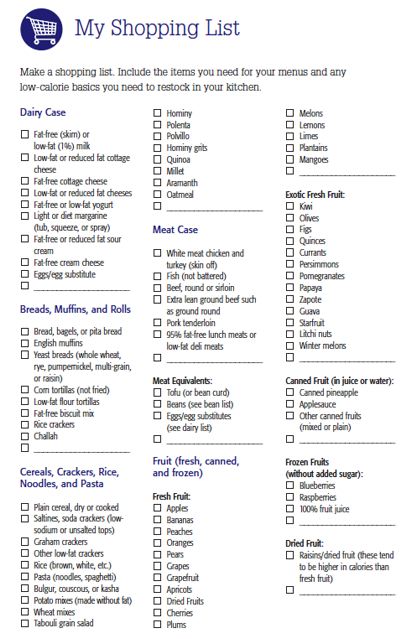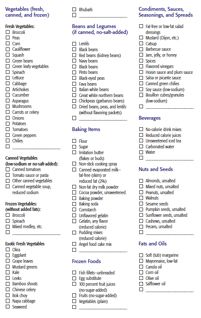
Have you ever wished you could easily build a customized grocery shopping list that would make it easier when it comes time to head to the farmers market and stores for supplies?
There are MANY “kitchen” and “pantry” focused food item shopping lists that have been posted over the years, with some being much more comprehensive than others.
In this technical age there are both low tech and high approaches to dealing with coming up with those grocery shopping lists and we’ll cover some details of each type of approach.
The bottom line is that there truly is no such thing as “one (pre-fab) shopping list fits all” when it comes to food shopping for unique individuals and families!
Obviously, it is critical to shop well before you can move on to the latter steps of food preparation that may involve cooking and then later on to eating, but everyone has to start somewhere.
Some grocery shopping lists will focus on ethnic and cultural preferences, or even religious or other moral preferences when it comes to what to buy so that you will be able to prepare the types of meals and snacks that you want yourself and any others in your home to eat.
For those who themselves have any special diet restrictions and/or have household members with such restrictions, any food item related shopping experience can be even a bit more challenging as food intolerances, allergies, or avoidances all require more careful label reading each and every grocery shopping trip. Greater awareness of issues of cross-contamination, ingredient changes, etc., make it necessary for the food item shopper to constantly be on the alert for changes in manufacturer’s products being sold in any marketplace.
A knowledgeable food item related purchaser is going to have to create their own grocery shopping list in order to take into account all of the many factors that affect searching for and obtaining the specific purchases that will meet their own unique household needs.
No matter whether you go low tech or high tech, implement (we prefer to actually organize) the grocery shopping list by reverse perishability to purchase shelf stable items first (more central aisles of stores) and end it with most perishable items to be added to your grocery cart last (perimeter of the store) right before check out.
For those who like higher tech options, courtesy of Ziplist, here is an infographic of the Anatomy of a Tech-Savvy Grocery Shopper.
Another site noted how people are using social access options in an attempt to deal with their supermarket shopping expeditions via Getting Social in the Supermarket.
Even the Happy Housewife has an infographic Grocery Store GPS How to Avoid Spending Traps since as that site notes and we all know, without some sort of plan, it is easy to overspend beyond your intentions since once you get to the grocery stores, enticements to overspend are in many eye level locations.
•A free grocery shopping list app for iPhone users updated: Jul 27, 2012 that is very popular is pushpins version 2.3.1 compatible with iPhone, iPod touch, and iPad where you can enter items by manual input from various categories or scanning barcodes for items you are running low on at home. You can even create checklists for specific grocery stores by aisle, however, the app, like most other similar apps of this type, doesn’t recognize various store brands or wholesale club packaging.
•Some free low tech lists on the www will be more skeleton like such as the Perfect Pantry List and Shopping List offered by North Carolina Extension, which also has been developing a program series on Eat Smart, Move More, Weigh Less designed to address a wide variety of family needs and tied into the Eat Smart, Move More North Carolina initiative which includes skeleton style Planning Aids & Guides. You can read a one page summary of the Eat Smart, Move More, Weigh Less program and also check out their Eat Smart North Carolina Healthy Snacks and Drinks Guide as well.
Lesson Titles in that series will include:
- Introduction
- Make Your Commitment
- Re-Think Your Drink
- Eat Fewer Calories
- Move More
- Check the Facts
- Enjoy More Vegetables
- Right-Size Your Portions
- Plan, Shop, Fix
- Eat Less Fast Food
- Move Strong
- Enjoy More Fruits
- Start Smart
- Move Forward
- Keep Your Commitment
- Eat Out Less
- Tame the Tube
- Pack Smart Lunches
- Enjoy More Whole Grains
You can also see their handout on Stock a Nutrient-Rich Pantry which will link you to more sites such as:
- Fruits and Veggies More Matters™ (Produce for Better Health Foundation)
- Fruit and Veggie Color Champions™ (Produce for Better Health Foundation)
- Incredible Egg http://www.incredibleegg.org/
- Meals Matter™ http://www.mealsmatter.org/ (maintained by Dairy Council of California)
- Whole Grains Council
•You’ve probably also heard of the “100 Foods Dr. Oz Wants In Your Shopping Cart” that was promoted through the Dr. Oz show and has been available at a jpg at his show’s website since September 2011. There are certainly a number of nutrient-rich food items included in that list, but please keep in mind that it still might not be the ideal list for all grocery shoppers.
•Other free advice on grocery shopping can be obtained from the American Cancer Society, the American Heart Association via their heart checkmark program, and other national organizations.
•Some sources of information for a fee can be obtained from the American Institute for Cancer Research (AICR), various Diabetes focused publications, etc.
•You can see an example of the AICR New American Plate Shopping Guide, part of a series of materials (AICR Guidelines for Cancer Prevention) that they sell focusing on the concept of the New American Plate for cancer prevention. Some of the other information on the AICR website is offered at no charge, such as their AICR List of Foods That Fight Cancer and a clickable Guide to the Nutrition Facts Label that is also on their website.
•You might also have heard of private publications and websites produced under RD direction that offer grocery shopping advice for a fee such as “Supermarket Savvy” and others such as “Diet Experts” with their springboard for creating your own grocery list.
•There is a fun exercise to determine Are You Food Shopping Savvy? put out by the University of KY that you can also check out for yourself.
 •The U.S. Dept. of Health and Human Services (USDHHS) has a very general suggested Heart Healthy Foods Shopping List which suggests that you “follow these tips for a healthy heart:
•The U.S. Dept. of Health and Human Services (USDHHS) has a very general suggested Heart Healthy Foods Shopping List which suggests that you “follow these tips for a healthy heart:
- Eat less saturated and trans fat. Stay away from fatty meats, fried foods, cakes, and cookies.
- Cut down on sodium (salt). Look for the low-sodium or “no salt added” brands of canned soups, vegetables, snack foods, and lunch meats.
- Get more fiber. Fiber is in vegetables, fruits, and whole grains.
[Consider taking a variation of] this list with you the next time you go food shopping [adapted for the needs of yourself and your family +/or friends].
Vegetables and Fruits
Eat a variety of vegetables and fruits. Buy them in season to save money.
- Fresh vegetables such as tomatoes, cabbage, broccoli, and spinach
- Leafy greens for salads
- Canned vegetables low in sodium (salt)
- Frozen vegetables without added butter or sauces
- Fresh fruits such as apples, oranges, bananas, pears, and peaches
- Canned fruit in 100% juice, not syrup
- Dried fruit
- Frozen berries without added sugar
Milk and Milk Products
Look for fat-free or low-fat milk products.
- Fat-free or low-fat (1%) milk
- Cheese (3 grams of fat or less per serving)
- Fat-free or low-fat yogurt
Breads, Cereals, and Grains
For products with more than one ingredient, make sure whole-wheat or whole-grain is listed first.
- 100% whole-wheat bread
- Whole-grain breakfast cereals like oatmeal
- Grains such as brown rice, barley, and bulgur
- Whole-wheat or whole-grain pasta
- Popcorn
Meat, Beans, Eggs, and Nuts
Choose lean cuts of meat and other foods with protein.
- Seafood
- Chicken and turkey breast without skin
- Pork: leg, shoulder, tenderloin
- Beef: round, sirloin, tenderloin, extra lean ground beef
- Beans, lentils, dried peas
- Eggs and egg substitutes
- Nuts and seeds
Fats and Oils
Cut back on saturated fat and look for products with no trans fats.
- Margarine and spreads (soft, tub, or liquid) with no trans fats
- Vegetable oil (canola, olive, peanut, or sesame oil)
- Non-stick cooking spray
- Light or fat-free salad dressing and mayonnaise”
•There is even a My Shopping List from an older government 2005 version of the Dietary Guidelines for Americans still on the www which if adapted and updated could be quite useful. We included a very reduced size version of page 1 of 2 of that pdf to open this blog post and note an even smaller size of page 2 of 2 of that pdf here, but you can still grab the original full size pdf off the www as of the date of this blog post. (The images are only shown for identification purposes as the pdf is part of that 2005 Dietary Guidelines program).
As we noted at the start of this blog post, the bottom line is that there truly is no such thing as “one shopping list fits all” when it comes to food shopping for unique individuals and families! There are quite a number of different approaches to “grocery lists” out there and each one has its pros and cons and none of them as is will be perfect for you or your family. Although no list can be just right for everyone, some lists do have more reminders on them than others of items to consider if they fit into the needs and wants of you and any other members of your family and friends.
Registered Dietitians with a high food and nutrition competency will ALWAYS suggest that food shoppers customize their shopping lists to the needs of their own household no matter what the household size is taking into account the needs of each individual household member.
Clinical Dietitians who work for various medical services in hospitals may or may not (many do!) have great cooking skills since their focus is on medical nutrition assessment and Medical Nutrition Therapy (MNT) care and there are RDs who focus on food systems management within the facility to address food specific needs.
Outpatient Dietitians who counsel free-living individuals, Public Health Nutritionists who work directly with the public, and Private Practice RDs who counsel individual clients (including through MNT) truly need those skills in order to translate nutrition advice into practical food advice the public can actually use.
Why not let a “real food” nutrition expert such as a RD help you tweak a grocery shopping list to let it be the best it can be to meet the needs of you and your family members?

